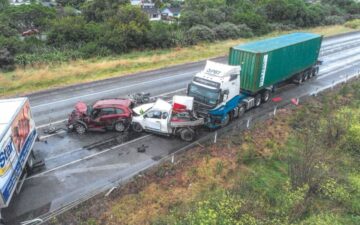You know that feeling when you’re driving down I-95 and suddenly there’s a massive 18-wheeler right beside you? Your hands grip the wheel a little tighter, and you wonder just how safe you really are sharing the road with these giants. We’ve all been there – and for good reason. The truth is, some trucks are statistically more likely to be involved in accidents than others, and understanding which ones can help keep you and your family safer on Maryland’s roads.
Every day, thousands of commercial trucks roll through Baltimore’s highways and streets, delivering everything from Amazon packages to construction materials. But not all trucks are created equal when it comes to safety. Some types of trucks have significantly higher accident rates, and the reasons might surprise you.
In this article, we’re gonna break down the real data about truck accidents – which trucks are most dangerous, why certain vehicles have more crashes, and what this means for drivers like you navigating Baltimore’s busy roads. We’ll also share some practical tips for staying safe around these vehicles and what you should know if you ever find yourself in an accident with one.
The Most Common Types of Trucks Involved in Accidents
When we talk about what trucks have the most accidents, we need to look at the different types of commercial vehicles sharing our roads. Each type brings its own unique challenges and risks.
Semi-Trucks and 18-Wheelers
These are the big boys – the ones that make your car feel like a toy when they pass by. Semi-trucks account for nearly 70% of all large truck accidents nationwide. Why? Well, think about it. They can weigh up to 80,000 pounds when fully loaded, their blind spots are massive (a car can disappear completely alongside them), and it takes them about 40% longer to stop than a regular car. Driver fatigue is also a huge issue since many drive cross-country routes.
On Baltimore highways like I-95 and I-695, these trucks are everywhere. They’re bringing goods to the Port of Baltimore, heading to distribution centers, or passing through on their way up and down the East Coast. The sheer number of them, combined with their size and limitations, makes them statistically the most accident-prone trucks on our roads.
Delivery Trucks
Remember when we used to get packages, maybe once a month? Now it seems like there’s a delivery truck on every corner, every day. Amazon, FedEx, UPS – they’re all racing to get packages to our doors faster than ever. And that’s where the problems start.
These medium-sized trucks are involved in accidents at an alarming rate, especially in urban areas like Baltimore. Drivers are often under intense time pressure, constantly stopping and starting in traffic. Many drivers are relatively inexperienced, and they’re navigating residential streets that weren’t designed for commercial vehicles.
The pressure to meet delivery quotas means these drivers are sometimes cutting corners – literally and figuratively. They’re double-parking, making risky turns, and rushing through yellow lights. It’s a recipe for accidents.
Dump Trucks and Construction Vehicles
With all the construction happening around Baltimore – from road repairs to new developments – dump trucks are a constant presence. These vehicles have their own unique dangers. They have limited visibility due to their high cabs, heavy loads that shift and affect stability, and they frequently enter and exit construction zones. They also often operate in areas with pedestrians and workers nearby.
Ever been stuck behind a dump truck on Northern Parkway during rush hour? You know how challenging it can be. These trucks need extra room to maneuver, and their drivers often can’t see smaller vehicles around them.
Tanker Trucks
These might be the scariest of all. Tanker trucks carrying fuel, chemicals, or other liquids have a particularly high risk profile. The liquid cargo shifts during movement, affecting balance. They have a higher rollover risk on curves and ramps, and there’s potential for catastrophic accidents if cargo spills. They also require specialized driver training and certification.
Around the Baltimore port area and industrial zones, tanker trucks are common. The combination of heavy traffic, complex road systems, and hazardous materials makes these vehicles particularly concerning.

Why Certain Trucks Have Higher Accident Rates
Understanding what trucks have the most accidents is only part of the story. We also need to know why these accidents happen so frequently.
Size and Weight Factors
Physics doesn’t lie – bigger vehicles are harder to control. Here’s what we’re dealing with:
- A fully loaded semi takes 525 feet to stop from 65 mph (that’s almost two football fields!)
- The higher center of gravity makes trucks more likely to roll over
- Wind resistance affects larger vehicles more dramatically
- Turning radius limitations create blind spots and tight situations
When you’re driving your Honda Civic next to an 80,000-pound truck, the physics aren’t in your favor if something goes wrong.
Driver Training and Experience
Not all truck drivers are created equal. While many are true professionals, the industry faces some serious challenges. High turnover rates mean lots of inexperienced drivers on the road. CDL requirements don’t always match real-world demands, and some companies prioritize speed over safety training. Language barriers can also affect understanding of safety protocols.
We’ve seen cases where drivers had their CDL for just weeks before being put on challenging routes through Baltimore. That’s like learning to swim in the deep end.
Industry Pressures
The trucking industry is under more pressure than ever, and safety sometimes takes a back seat. Just-in-time delivery demands create unrealistic schedules. While electronic logging devices catch hours violations, the pressure remains intense. The driver shortage means companies sometimes lower their standards, and competition drives companies to push limits.
When drivers are worried about losing their jobs for late deliveries, they might take risks they normally wouldn’t. It’s a systemic problem that affects everyone on the road.
Regional Truck Accident Patterns in Maryland
Baltimore and Maryland have unique traffic patterns that affect truck accident rates. Understanding these can help you stay safer.
Baltimore Metropolitan Area Statistics
Our area sees specific challenges. The I-95 corridor has the highest truck accident rate in Maryland. The Baltimore Beltway (I-695) sees frequent truck rollovers. Downtown streets weren’t designed for modern truck sizes, and port traffic creates congestion and risky situations.
Peak accident times in our area:
- Morning rush (6-9 AM)
- Evening rush (3-6 PM)
- Friday afternoons (especially before holidays)
- During rain or snow events
Common Accident Locations
If you drive in Baltimore regularly, you probably already know these trouble spots:
- I-95 and I-495 interchange
- I-695 at I-70 (the infamous “spaghetti junction”)
- Route 40 through the city
- I-83 near the Pepsi sign
These areas combine heavy truck traffic, complex road designs, and high speeds – a dangerous combination.
Understanding Your Rights After a Truck Accident
Nobody wants to think about being in a truck accident, but knowing what to do can make all the difference if it happens.
Immediate Steps to Take
If you’re involved in a truck accident:
- Get to safety first – move out of traffic if possible
- Call 911 immediately, even for “minor” accidents
- Document everything – photos, witnesses, truck company info
- Don’t admit fault or sign anything at the scene
- Get medical attention, even if you feel fine
Truck accidents are different from regular car accidents. There might be multiple parties involved – the driver, trucking company, cargo loader, maintenance company. It gets complicated fast.
Legal Considerations
Truck accident cases involve unique factors. Federal regulations might have been violated. There are multiple insurance policies and coverage limits to navigate. Corporate liability issues come into play, and black box data needs preserving. Time-sensitive evidence collection is crucial.
We always tell people – don’t try to handle a truck accident claim yourself. These companies have teams of lawyers ready to minimize their liability.
Seeking Professional Help
After a truck accident, you need someone in your corner who understands Federal Motor Carrier Safety Regulations, how to preserve crucial evidence, dealing with multiple insurance companies, and the true value of your injuries and losses.
The sooner you get help, the better your chances of fair compensation. Evidence disappears, memories fade, and insurance companies work fast to protect their interests.
Safety Tips for Sharing the Road with Trucks
While we can’t control what trucks have the most accidents, we can control how we drive around them.
Defensive Driving Strategies
Stay safe by following these key rules:
- Never cut in front of a truck – they need that space to stop
- Stay out of blind spots – if you can’t see their mirrors, they can’t see you
- Pass quickly and safely – don’t linger beside trucks
- Give trucks extra room in bad weather
- Watch for turn signals – trucks need wide turns
Weather Considerations
Maryland weather creates extra challenges. Rain creates spray that blinds drivers. Snow and ice affect trucks differently than cars. Wind can push trucks into other lanes, and fog reduces visibility for everyone.
During bad weather, give trucks even more space than usual. That spray from their tires isn’t just annoying – it’s dangerous.
Conclusion
So what trucks have the most accidents? The data shows semi-trucks lead the pack, followed closely by delivery trucks, construction vehicles, and tankers. But more important than the statistics is understanding why these accidents happen and how to protect yourself. Every day on Baltimore’s roads, we share space with these massive vehicles that are essential to our economy but pose real risks. By understanding which trucks are most dangerous and why, we can make smarter decisions about how we drive and stay safer on Maryland’s highways.
Remember – if you’re ever involved in a truck accident, don’t try to handle it alone. The trucking companies have entire teams of lawyers and resources on their side, ready to minimize their liability. That’s why you need a Baltimore truck accident law firm that knows how to fight for your rights. At The Snyder Law Group, we understand the complex regulations and unique challenges of truck accident cases. We’re here to help you get the compensation you deserve while you focus on recovery. Stay safe out there, Baltimore, and if you need us, we’re just a phone call away at (410) 843-3476.
